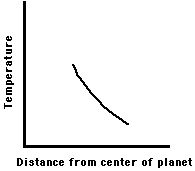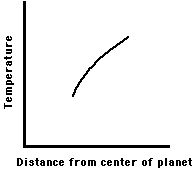What is the primary process in the formation of Uranus and Neptune that led to their smaller size relative to the other two gas giants, Jupiter and Saturn?
--
Suppose a gaseous planet has a temperature profile in its atmosphere as shown below.
a) (4 pts) The source of this planet’s heat is (internal/external/can’t determine).
b) (8 pts) Explain your answer to part (a).
 /
/ 
--
We think that the source of the magnetic field in Neptune is its mantle of water-ice.
a) (6 pts) Explain why we think the source is water-ice rather than, say, metal (like with the terrestrial planets).
b) (6 pts) How do we know that the field is based in the mantle rather than the core? A diagram may be used to help explain this answer.
--
Neptune’s moon, Triton, has a similar size and composition to Saturn’s moon, Titan. Triton also formed in a cold environment like Titan.
a) (6 pts) What is the evidence that leads us to believe that Triton has a very thin atmosphere? Explain.
b) (6 pts) Why do we think Triton’s atmosphere so thin relative to Titan’s? Explain.
--
Tidal interactions can be used to explain several phenomena in planetary astronomy, including things outside our own solar system.
a) (6 pts) Tidal forces are currently pulling Neptune’s moon Triton inward, and this fact is related to Triton’s origin. Explain how we know that Neptune’s moon Triton is a captured satellite rather than one that formed as part of the Neptune system originally.
b) (8 pts) When large planets form in other solar systems, some models suggest that they spiral inward toward their parent star due to a kind of frictional force with the dusty disk they formed from. Explain two reasons (one of them having to do with tidal forces) why in these models the planets stop spiraling inward and are left at very close distances to their parent stars (which would explain dozens of the systems seen so far that look like this).
--
When the Voyager spacecraft flew past Jupiter, it discovered a faint ring system. It turns out that all four of the outer planets have ring systems.
a) (4 pts) What is the origin of the ring material that makes up Jupiter's faint ring? Just state it, no explanation needed.
b) (4 pts) State and briefly explain the evidence that tells scientists Saturn's ring system is not one solid object but a system of small, independently orbiting ring particles.
c) (6 pts) How did Astronomers discover a ring system around Uranus? Explain.
--
We know that its distance from the Sun is a major factor which indirectly allowed Jupiter to become a very massive planet relative to the terrestrial worlds. The planet Neptune is much further from the Sun compared to Jupiter, so why did Neptune not become an even larger world?
--
Name and explain the reason why Jupiter and Neptune have such different colors, despite the fact that both are made up of almost exactly the same substances.